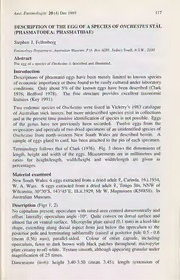
Description of the egg of a species of Onchestus Stal (Phasmatodea: Phasmatidae) PDF
Preview Description of the egg of a species of Onchestus Stal (Phasmatodea: Phasmatidae)
Aust. Entomologist 20 (4) Dec 1993 117 DESCRIPTION OF THE EGG OF A SPECIES OF ONCHESTUS STÀL (PHASMATODEA: PHASMATIDAE) Stephen J. Fellenberg Entomology Department, Australian Museum, P.O. Box A285, Sydney South, N.S.W., 2000 Abstract The egg of a species of Onchestus is described and illustrated. Introduction Descriptions of phasmatid eggs have been mostly limited to known species of economic importance or those found to be easily cultured under laboratory conditions. Only about 596 of the known eggs have been described (Clark 1976; Bedford 1978). The fine structure provides excellent taxonomic features (Key 1991). Two endemic species of Onchestus were listed in Vickery's 1983 catalogue of Australian stick insects, but more undescribed species exist in collections and at the present time positive identification of species is not possible. Eggs of the genus have not previously been recorded. Twelve eggs from the ovipositors and opercula of two dried specimens of an unidentified species of Onchestus from north-western New South Wales are described herein. A sample of eggs glued to card, has been attached to the pin of each specimen. Terminology follows that of Clark (1976). Fig. 3 shows the dimensions of length, height and width of the eggs. Measurements are in millimetres and ratios for height/length, width/height and width/length are given as percentages. Material examined New South Wales: 6 eggs extracted from a dried adult ?, Carinda, 16.1.1934, W. A. Wass. 6 eggs extracted from a dried adult ?, Tongo Stn, NNW of Wilcannia, 30°309S, 143°459E, 18.11.1929, Mr W. Magnussen (K58858). In Australian Museum. Description (Figs 1, 2) No capitulum present; operculum with raised area centred dorsoventrally and offset laterally; operculum angle -10?. Quite convex on dorsal surface and almost flat on ventral surface. Micropylar plate raised (0.1 mm) in a keel-like shape, extending along dorsal aspect from just below the operculum to the posterior pole and terminating sublaterally (raised at posterior pole 0.5 - 0.6 (mean 0.56) mm); parallel-sided. Colour of entire capsule, including operculum, fawn to dark brown with black patches throughout; micropylar plate creamy to off-white. Texture smooth, although appearing granular under magnification of 25 times. Dimensions (n=6): height 3.40-3.50 (mean 3.45); length (extension of Aust. E: ntomologist 20 (4) Dec 1993 E dyu e vedà ai jaa)5 Do D © = Q z2 S Ss Y e n 2 ke] n a 4 E 4^ S 2o b T e n A o o af 2a ~ © 9 nmn TS [s]n a o o E [27o ale line ] mm. Aust. Entomologist 20 (4) Dec 1993 119 ZA Operculum Micropylar plate P Capsule b Fig. 3. Generalised egg of Onchestus sp.: (a) lateral aspect; (b) dorsal aspect. micropylar plate included) 5.70-5.94 (mean 5.82); width 2.50-2.50 (mean 2.50); micropylar plate (at centre) 0.2-0.2 (mean 0.2); height/length 57-61 (mean) 59); width/length 42-44 (mean 43); width/height 71-74 (mean 712.5). Discussion Onchestus was placed by Günther (1953) in the Phasmatini and the egg recorded herein is similar to the known eggs of other species in this tribe. It differs, however, in having the micropylar plate greatly extended, reaching from near the operculum to beyond the posterior pole, where it is markedly keel-shaped. Acknowledgments l I would like to thank Max Moulds for helpful comments on the manuscript and Geoff Aven for assistance with microphotographs. Special thanks are due to Mark Manly (Sydney Institute of Technology SEM unit) for taking the electronmicrographs. References BEDFORD, G.O. 1978. Biology and ecology of the Phasmatodea. Annual Review of Entomology 23: 125-149. 120 Aust. Entomologist 20 (4) Dec 1993 CLARK, J.T. 1976. The eggs of stick insects (Phasmida): a review with descriptions of the eggs of eleven species. Systematic Entomology 1: 95-105. GÜNTHER, K. 1953. Über die taxonomische Gliederung und die geographische Verbreitung der Insektenordnung der Phasmatodea. Beitrage zur Entomologie 3: 541-563. KEY, K.H.L. 1991. Phasmatodea (stick insects). Chapter 25 in The Insects of Australia. Melbourne University Press, Melbourne. Vol I. Pp. 394-404. VICKERY, V.R. 1983. Catalogue of Australian stick insects (Phasmida, Phasmatodea, Phasmatoptera or Cheleutoptera). CSIRO Australia Division of Entomology. Technical Paper 20: 1-19.
